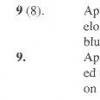
28-10-2025 19:33
 Nicolas Suberbielle
Nicolas Suberbielle
Bonjour à tous,Je voudrais votre avis sur cette r

31-10-2025 09:19
 Lothar Krieglsteiner
Lothar Krieglsteiner
Can somebody provide me with a file of:Rogerson CT

09-08-2025 13:13
 Maria Plekkenpol
Maria Plekkenpol
Hello,Yesterday I found these on burnt soil. Apoth

25-11-2016 13:54
 Stephen Martin Mifsud
Stephen Martin Mifsud
Hi, I found numerous seeds of Washingtonia robusta

28-10-2025 22:22
 Bernard Declercq
Bernard Declercq
Hello.I'm searching for the following paper:Punith

28-10-2025 15:37
Carl FarmerI'd be grateful for any suggestions for this strik

Now I make "a little revision" of old specimens. So, there are Pezicula cf. acericola and P. cf aesculea, identified by previous researcher.
According to Verkeley, 1999 ("A Monograph of the genus Pezicula..."): P. aesculea has a bit "thinner" spores with L/W 3,6-4,4, while P. acericola has "thicker" spores with L/W 3,2-3,5.
In my specimen: Pezicula cf. acericola has L/W 3,1-5,3, mostly 3,8-3,9. Pezicula cf. aesculea L/W 3,3-4,2, mostly near 4.
Other differences: Pezicula cf. acericola has slightly larger apothecia, 1-2 mm, in small clusters consisting of 4-6 fruitbodies, Pezicula cf. aesculea has smaller fruitbodies, 0,5-1,2 mm, up to 13 in cluster.
First I thought, that I just have one species. But here, in Ascofrance database, I see 2 interesting records:
http://www.ascofrance.com/search_recolte/1646# - Pezicula aesculea, with quite "thick" spores and
http://www.ascofrance.com/search_recolte/2290 - Pezicula acericola, with quite "thin" spores and L/W 2,5-5.2!!
So, I' m confused. Where is the misunderstanding? Is L/W parameter important for distinguishing of these species? What are other important parameters?
Hope for your help very much,
Irina

Confusion is the base of science :-)
it seems that the both names have been mixed up unfortunately in both collections.
Note that in 1646 the last 2 photos are macroconidia, recognized by the flattened end.
The L/W ratio is the distinguishing feature, supplementary to that the spores are sometimes curved at the base in aescula.
the size and margin feature are from minor importance because this can be dependent of external influences.
As for the number of apothecia that are arising from one stroma (in acericola up to 13) this does not exclude 4-6
Your both collections seems to fit to aescula.
I hope this was of any help
Stip

Thank you for explanation, Stip!
To be more presice, in "acericola" clusters consisted of mainly 3-4-5 up to 6 fruitbodies, in "aesculea" clusters were 7-8-9 up to 13 fruitbodies.
But now with your comments I come back to idea that I have one species - aesculea. Furthermore, I have spores with curved ends in both cases.
Cheers,
Irina

